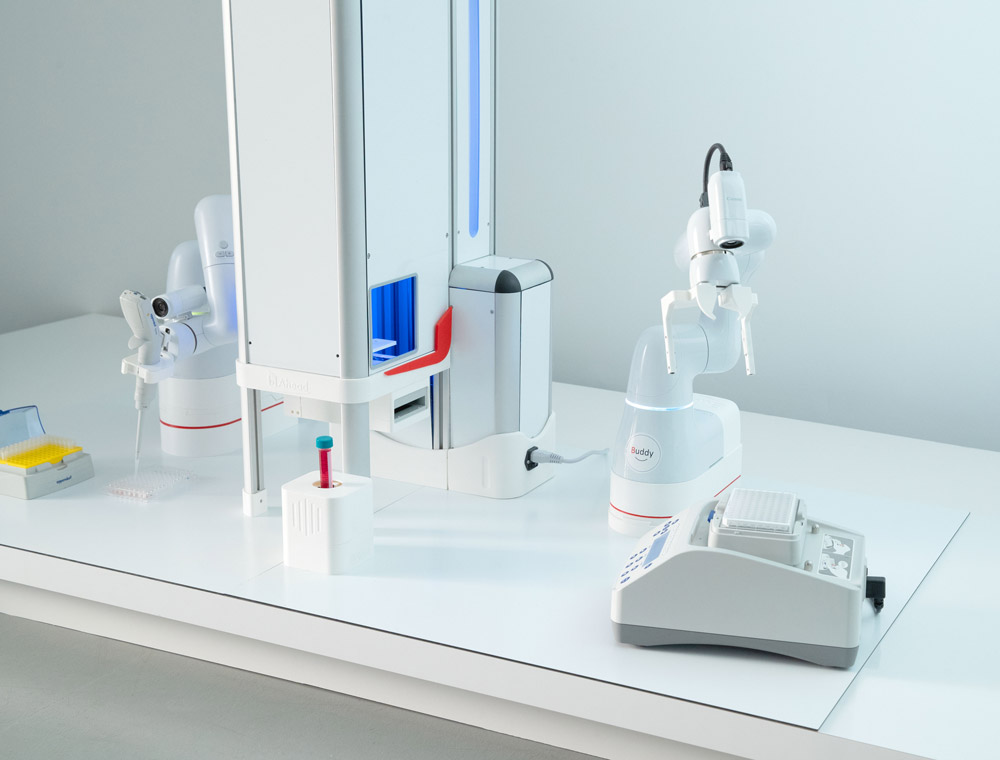"Futurelab": In the automated lab of the future, COBOTTA from DENSO Robotics takes over the central function
"Futurelab": In the automated lab of the future, COBOTTA from DENSO Robotics takes over the central function.

Modern test and product labs are currently facing enormous challenges: In view of the Covid-19 pandemic, increasing global competition and cost pressure, as well as the local shortage of skilled workers, laboratories already working at their capacity limits need to cut costs and increase their efficiency. A new, pioneering solution is robotic automation with cobots, such as DENSO Robotics' COBOTTA, which are specially designed for safe human-robot collaboration (HRC): COBOTTA is at the heart of the "Futurelab," an innovative lab concept from Hamburg-based startup bAhead GmbH.
"The lab of tomorrow will be digitized in the simplest and most flexible way. Robots like COBOTTA and its ecosystem are likely to become the new standard for laboratory automation thanks to the many advantages and rapid further development such as AI," says Rainer Treptow, founder and CEO of bAhead GmbH, which was able to convince two strong industry partners, IAV Automotive Engineering and DENSO Robotics. "We are combining three disruptive technologies for the first time in the laboratory sector - collaborative robots, drones as well as artificial intelligence." This creates a very different dynamic than traditional lab automation, especially for labs that need to automate despite small sample numbers, he said.
"The decisive advantage of COBOTTA is its central function for uncomplicated networking of devices in the laboratory. Our robot eliminates the need for time-consuming interface programming, so that proven equipment already in the lab can continue to be used - saving costs and time," explains Carsten Busch, Product Manager Cobots, DENSO Robotics. COBOTTA thus enables highly effective, flexible and cost-efficient laboratory automation for life science, biotech and medtech laboratories, which is also suitable for environmental, food and industrial laboratories. Since COBOTTA does not require a protection cell or complex programming, its use is economically viable even for medium-sized companies; the purchase usually pays for itself in just a few months. The modular, multifunctional design of the "Futurelab" optimizes the competitiveness and flexibility of a laboratory so that, for example, a multiple of the sample volume can be handled at a fraction of the cost.
The connecting key technology in the "Futurelab" is COBOTTA, whose central function is to network all the equipment in the laboratory. In addition, the robot performs a wide variety of laboratory tasks. An autofocus camera mounted on the arm detects positions and changes, e.g. of mixers or rotors, which can thus be readjusted via AI. This makes the robot a multi-talent - from intelligent pick-and-place and opening or closing of vessels to device operation and reading of e.g. displays, barcodes and data digitization or transmission. The robot can, for example, approach a microtiter plate - a standard sample format for examining biological properties of samples -, with 96 wells (small vessels for the samples) at a speed of just 50 seconds per well, accurate to 5/100 mm, and dip into one well at a time - an excellent value, according to Rainer Treptow.
After a careful product comparison, the company decided on COBOTTA because it offered the best combination for an all-round safe MRK solution. COBOTTA was convincing thanks to its open platform, ease of use and TÜV-certified functional safety with its inherently safe design. Decisive for the application were the technical parameters of COBOTTA, such as the speed adapted to the human, the high repeatability (± 0.05 mm) and the low dead weight of only 4 kg with a payload capacity of up to 500g.
In the "Futurelab", a rail system makes the COBOTTA mobile for use at various workstations and extends the robot's radius of action - on the work tables and at height, because most applications are about 10 cm above the work surfaces or require reaching in, e.g. when the robot arm has to reach into a centrifuge. The Rail System thus expands the performance spectrum of the laboratory and increases efficiency: the robot can take over a different task at different workplaces in just a few minutes, thus providing a high multiple benefit and significant cost savings, especially in the start-up phase of a laboratory automation system.
Intelligent logistics also includes the "tower hotel," a cost-efficient, multifunctional and fully automated high-bay warehouse for standardized containers for a wide variety of contents such as consumables, samples or reagents (chemical substances that show a specific reaction when they come into contact with other substances), as well as drones for laboratory logistics. Another technology in use is Artificial Intelligence: an AI-based central control system acts as the "brain" of the lab, understanding all processes, i.e. devices, drones, tower hotel and COBOTTA, and controlling them via AI or swarm intelligence if necessary. Workflows are scheduled, started and monitored via a terminal device such as a tablet or laptop. The system control documents every step and thus enables data-based quality management. In addition, there is a connection to a cloud, equipped among other things with an open source database for COBOTTA program modules, devices and consumables, to which users have access: In the long term, this will create a self-optimizing system with a valuable database.
Currently, prototypes and partially existing design patterns for the innovative laboratory system are being further optimized so that a complete setup of the first "Futurelab" can take place in mid-2021 and the beta test phase at the end of the year.
More about bAhead GmbH: www.bahead.de
More about DENSO Robotics: www.densorobotics-europe.com
